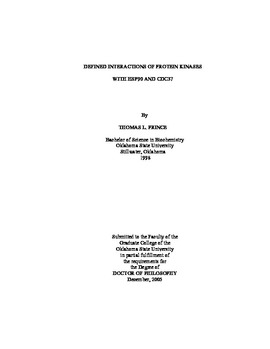| dc.contributor.advisor | Matts, Robert L. | |
| dc.contributor.author | Prince, Thomas L | |
| dc.date.accessioned | 2013-11-26T08:22:57Z | |
| dc.date.available | 2013-11-26T08:22:57Z | |
| dc.date.issued | 2005-12 | |
| dc.identifier.uri | https://hdl.handle.net/11244/6668 | |
| dc.description.abstract | Scope and Method of Study: Protein kinases function to transduce the countless number of signals that allow a cell to grow and adapt to its environment. A significant number of protein kinases require assistance in being folded and converted into functional signal transducers from nascent polypeptides or in maintaining their functional conformation once folded. This assistance is provided by the molecular chaperone Hsp90 and its cohort Cdc37 which together function to fold protein kinases through a series of direct interactions: a dynamic process which remains poorly understood. Deletion and site specific mutagenesis was used to generate newly synthesized epitope tagged protein kinase constructs in a reticulocyte lysate coupled transcription and translation system. This was followed by immunoabsorption of the constructs and subsequent analysis of the co-absorbing endogenous Hsp90 and Cdc37. | |
| dc.description.abstract | Findings and Conclusions: In this work the interactions of three unique protein kinases with Hsp90 and Cdc37 were studied. Lck, a Src-family tyrosine kinase, which is widely known to interact with Hsp90 and Cdc37. Cdk2, a cyclin-dependent protein kinase, which has been found to genetically, although not physically, interact with Hsp90 and Cdc37. And JNK1-alpha-1, a stress activated protein kinase, which has been shown not to interact with either Hsp90 or Cdc37. The results of this work indicate that: (i) Hsp90 interacts with structural motifs found in both the N-terminal and C-terminal lobes protein kinases; (ii) Cdc37 interacts exclusively with the N-terminal lobe of protein kinases; (iii) depending on the kinase the presence of different structural motifs within the N-terminal lobe are required for Cdc37 interaction; and (iv) the minimum protein kinase structure required for high affinity salt stable Hsp90 and Cdc37 interaction is the N-terminal lobe through the stabilized alpha-E-helix in the C-terminal lobe. In turn, these findings provide insight into how Hsp90 and Cdc37 recognize, bind and fold client protein kinases. In addition, these findings provide clues to the evolutionary relationship between the Hsp90 chaperone machine and protein kinases. | |
| dc.format | application/pdf | |
| dc.language | en_US | |
| dc.rights | Copyright is held by the author who has granted the Oklahoma State University Library the non-exclusive right to share this material in its institutional repository. Contact Digital Library Services at lib-dls@okstate.edu or 405-744-9161 for the permission policy on the use, reproduction or distribution of this material. | |
| dc.title | Defined interactions of protein kinases with Hsp90 and Cdc37 | |
| dc.contributor.committeeMember | Essenberg, Richard C. | |
| dc.contributor.committeeMember | Soulages, Jose L. | |
| dc.contributor.committeeMember | Massiah, Michael | |
| dc.contributor.committeeMember | Burnap, Robert | |
| osu.filename | Prince_okstate_0664D_1524.pdf | |
| osu.accesstype | Open Access | |
| dc.type.genre | Dissertation | |
| dc.type.material | Text | |
| dc.subject.keywords | protein kinases | |
| dc.subject.keywords | molecular chaperones | |
| dc.subject.keywords | hsp90 | |
| dc.subject.keywords | cdc37 | |
| dc.subject.keywords | signal transduction | |
| dc.subject.keywords | evolution | |
| thesis.degree.discipline | Biochemistry and Molecular Biology | |
| thesis.degree.grantor | Oklahoma State University | |
